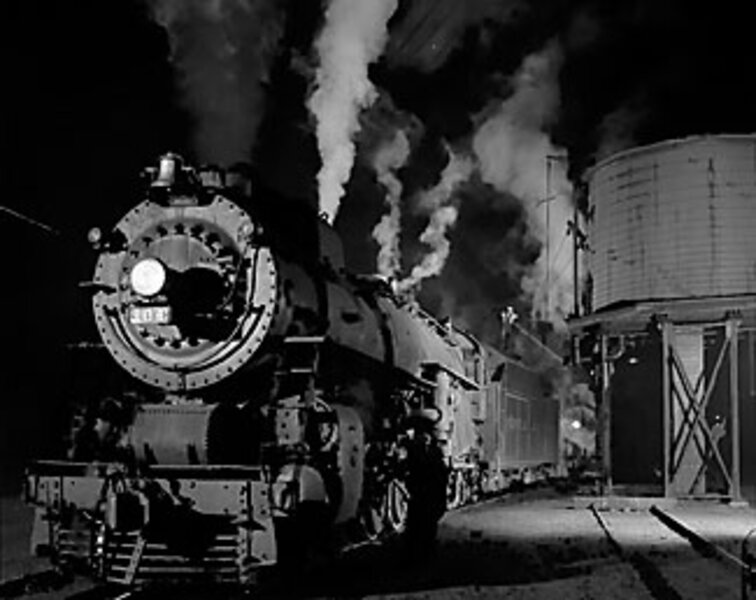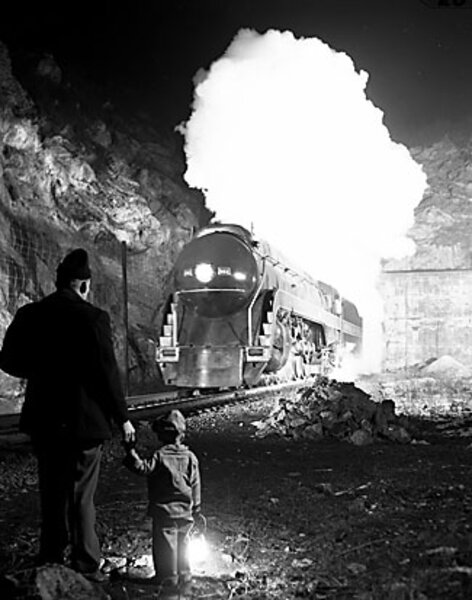For kids: A link to railroad history
Loading...
No doubt you are familiar with the image of a train chugging forward, spewing out a fat column of steam. You may have even drawn it yourself. But you've probably never seen such a sight on a commercial railroad.
That's because railroad engines today are usually powered by a combination of diesel and electricity.
Years ago, though, most train engines burned coal to heat water. That created steam, which drove a piston, which in turn moved the train's wheels. When the steam escaped the engine, it let out a gasping noise – the "choo-choo" sound – we all associate with old trains.
All that steam trailing outside the train meant a loss in heat and energy, which could have been used to power the train. To save energy, most railroads in America switched to diesel locomotives after World War II. However, one railroad – the Norfolk and Western (N&W) Railway in Roanoke, Va. – continued to use steam engines.
At the time, a professional photographer from Brooklyn, N.Y., named O. Winston Link, decided to take photographs of N&W steam engines before they disappeared.
No one paid Mr. Link to take photos of the trains – his project was just a hobby. From 1955 to 1960, he took 2,400 photographs of N&W trains, in Virginia, West Virginia, North Carolina, and Maryland.
Eventually, Mr. Link became famous for his photographs. And today you can see his collection at the O. Winston Link Museum in Roanoke.
Mr. Link not only photographed steam engines, he was also interested in capturing images of railroad towns. In the steam-engine era, towns across the country grew up and survived along railways by supplying railroads with their needs. Steam engines had to stop regularly to pick up coal, water, and fresh crews. When steam engines were replaced by more efficient diesel trains, railroad towns lost a big source of their business.
But "Link wasn't complaining about the end of steam power," says Kimberly Parker, director of the Link Museum. "He knew it was coming. He was just trying to capture the trains and the life that was created because of them."
That's one reason why many of Link's photos contain people as well as trains. In addition to photos of steam engines, the museum has a heritage gallery that resembles the general store of one of Virginia's old railway towns.
These general stores "were like a 1950s Wal-Mart," says Leah Gardner, the museum's education coordinator.
But you won't find the equipment Link used to photograph steam engines in a Wal-Mart today.
First of all, there were no digital cameras. Mr. Link's large Graphic View cameras used film. They had a collapsible, accordionlike midsection, which was used to focus the camera.
Most of Mr. Link's train photographs were also taken at night, which required lighting. He had special flash devices custom made, and he is considered to be the first photographer to use indoor studio-style lighting outdoors.
At the time, the flashbulbs available to photographers could be used only once. Sometimes, if one or more of the bulbs didn't flash, the photo didn't turn out as Mr. Link wanted, and he had to take another one. By the time he could replace the bulbs, however, the train he wanted to photograph may have been long gone.
Fortunately, he took careful notes for each of his photographs. He recorded the locations of his camera and lighting equipment, and the important details of the photograph. If he needed to retake a photograph, he could return later and arrange everything as it had been. Sometimes, a year or more passed before he could take the photograph again.
Mr. Link worked hard to get the photographs he wanted. Once, he built a special platform for his camera atop a railroad station. Another time, he spent a week setting up along a river for a photo of a train crossing a bridge.
Mr. Link also recorded the sounds of steam engines. For many years, he was more famous for his recordings than for his photographs. Eventually, people came to appreciate his photographs of steam engines and railway communities.
Later, though, many museums wanted to display his photographs. When Roanoke, the headquarters city of N&W, voiced a willingness to support a museum devoted to his photos, Mr. Link agreed. In 2004, the O. Winston Link Museum opened in the city's former passenger train station. Every year thousands of people visit the museum to see his photos, which link us to the past.






